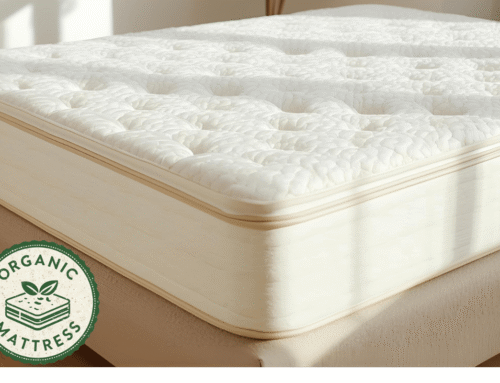Cleaning up a mess on a memory foam mattress can feel stressful, especially since the foam quickly soaks up liquid. Whether it’s a child’s bedwetting accident, a pet’s mess, or a spilled drink, it’s not easy to deal with. Memory foam holds onto moisture, so acting fast is important. Most people reach for store-bought cleaners, but they often don’t work well. A mix of baking soda and vinegar usually does a better job. It breaks down smells without adding any strong chemical scent. Letting the mattress dry completely in sunlight also helps a lot more than using a fan or dryer.
This guide shares simple steps that people have used and trusted. From removing stains to getting rid of odors, everything here uses things you probably already have at home. We’ll show you what works, what doesn’t, and how to get your mattress clean again.
Understanding what a memory foam mattress and a gel memory foam mattress are, knowing how much they typically cost, and identifying the best thickness for comfort all help with proper care. It is also important to consider the time a memory foam mattress takes to fully expand and the effects of sleeping on it before 48 hours.
Key Takeaways
- Act quickly and blot spills right away to keep urine or liquid from seeping deep into memory foam and causing lasting odors.
- A vinegar-and-water solution offers a safe, effective way to neutralize smells without using harsh chemicals, perfect for foam mattresses.
- Baking soda helps pull out trapped moisture and odors. Let it sit overnight, then vacuum slowly to lift everything out thoroughly.
- Allow the mattress to dry completely in fresh air or sunlight. This step helps prevent mildew, mold, and that musty smell from settling in.
- A waterproof mattress protector guards against future accidents. It keeps your mattress cleaner, smelling fresh, and lasting longer.
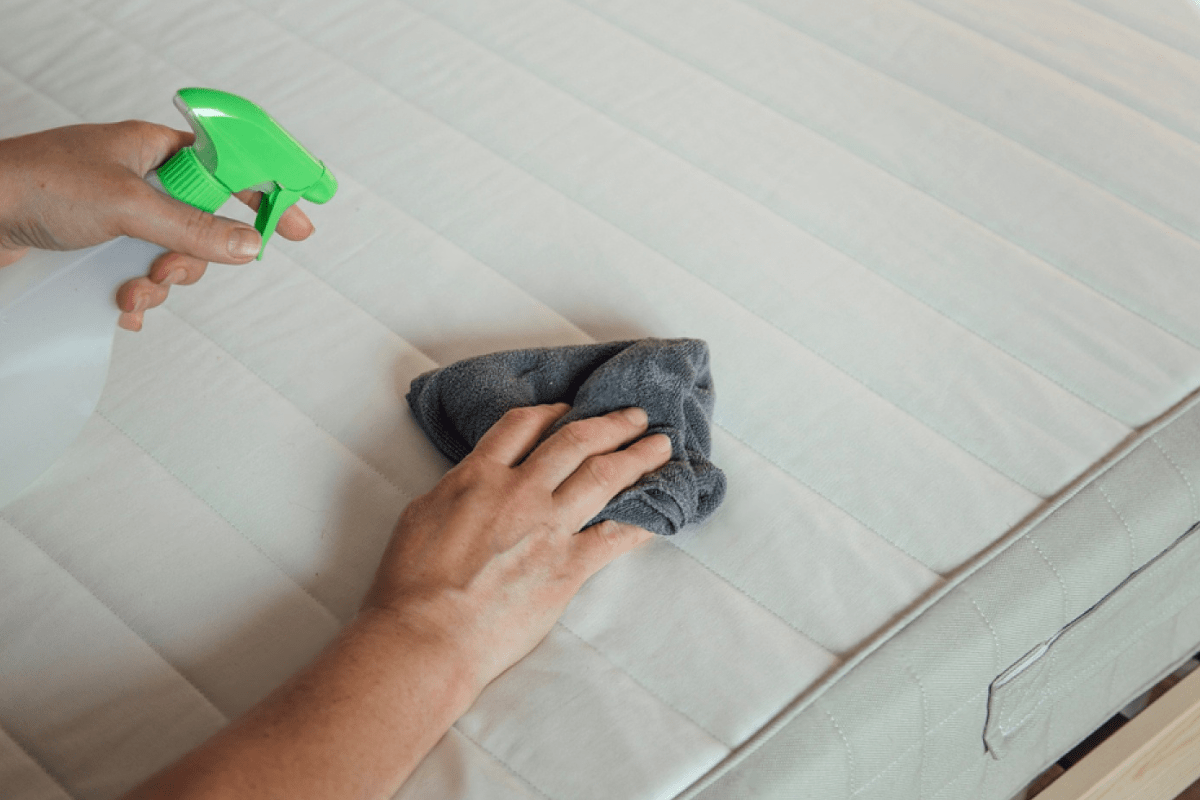
Act Fast And Blot The Area
When your pet has an accident, cleaning it up right away makes a big difference. It stops strong smells from setting in and helps prevent stains.
Use paper towels or a clean cloth to press down on the spot. Don’t rub it. Rubbing pushes the urine deeper into the surface and makes things worse. Pressing firmly pulls more liquid out without spreading it around. If the area is big or still feels wet, you’ll probably need a few towels. Try to dry the spot as much as you can as this helps the next cleaning step work better.
If you skip this part, the smell might come back later even after cleaning. You might have to blot a few times, but most people find it’s worth the effort. Getting out as much moisture as possible early on helps avoid problems down the line.
Use A Vinegar Cleaning Solution
For effective cleaning and stain removal on memory foam mattresses, vinegar and water solution works great. Equal parts white vinegar and water go into a spray bottle, then get sprayed directly on the affected spot. This mix tends to help with both stain removal and neutralizing odor without relying on harsh chemicals.
The area should be damp but not soaked, since excess moisture can be harder to dry. After spraying, letting it sit for 10 to 15 minutes usually gives it time to break down the stain. Many notice a change in smell during this stage, even before drying fully.
Blotting with a dry towel afterward helps lift both the moisture and odor. Some prefer using an old cotton shirt or microfiber cloth to avoid lint. Results vary depending on how deep the stain set is, though a light vinegar smell may linger briefly and fade as it dries.
Sprinkle Baking Soda To Absorb Odor
Baking soda helps absorb moisture and trap odors deep inside a memory foam mattress. A generous sprinkle over the affected spot usually helps, especially after blotting out as much liquid as possible. Many notice the smell fading faster with a thick layer instead of a light dusting.
Leaving it untouched for 8 hours or overnight gives the powder time to pull out moisture still trapped in the foam. Skipping this step too soon often leads to the odor sticking around longer than expected. Patience here tends to pay off the next day.
Some find that vacuuming up the powder in the morning leaves the mattress smelling clean and dry. For stubborn smells, repeating the process works better than scrubbing or adding liquids. It’s a simple fix that relies more on time and absorption than harsh cleaners, which also contributes to making the memory foam mattress cooler and helps prevent dips by maintaining proper airflow and reducing moisture buildup.
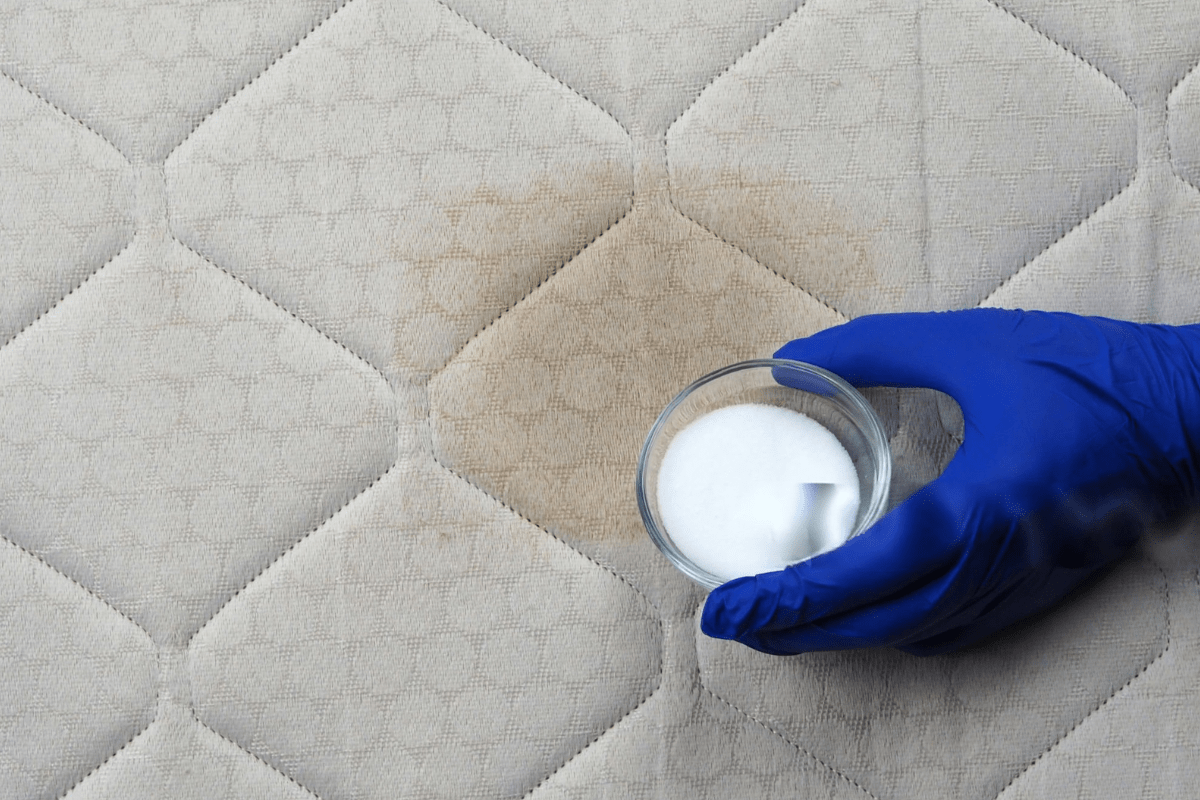
Vacuum It All Up
Baking soda sits on fabric to absorb odors, but it doesn’t just disappear. A vacuum with a brush or upholstery tool helps lift the powder without damaging cushions or fabric. Running the vacuum slowly across the surface gives better results than quick passes. Drying the foam thoroughly before reapplying anything is just as important so we also need to know how to dry memory foam mattress and how to clean memory foam mattress for best results.
Some people notice that one round of vacuuming leaves behind a bit of residue. That’s normal, especially if the powder settled deep into the fibers. Going over the spot two or three more times usually clears everything out.
If there’s still a lingering smell, another light sprinkle of baking soda overnight can help. Just be sure the fabric is dry before doing it again, or the powder may clump and get harder to remove.
Use An Enzyme Cleaner For Deep Odors
Old pee stains are hard to get rid of because they sink deep into the carpet and padding. Most regular cleaners can’t fix that. But enzyme cleaners break down the proteins and bacteria that cause the smell. They don’t just cover it up like vinegar or air fresheners.
You can find enzyme sprays at pet stores or online. A quick spray is usually enough, you don’t have to soak the spot. Just leave it alone and let it dry completely.
A lot of people say enzyme sprays worked better than anything else they tried, even on old stains. The trick is to be patient. Let the cleaner do its job. If the smell sticks around, you can spray it again once or twice, especially if the stain sat for a while.
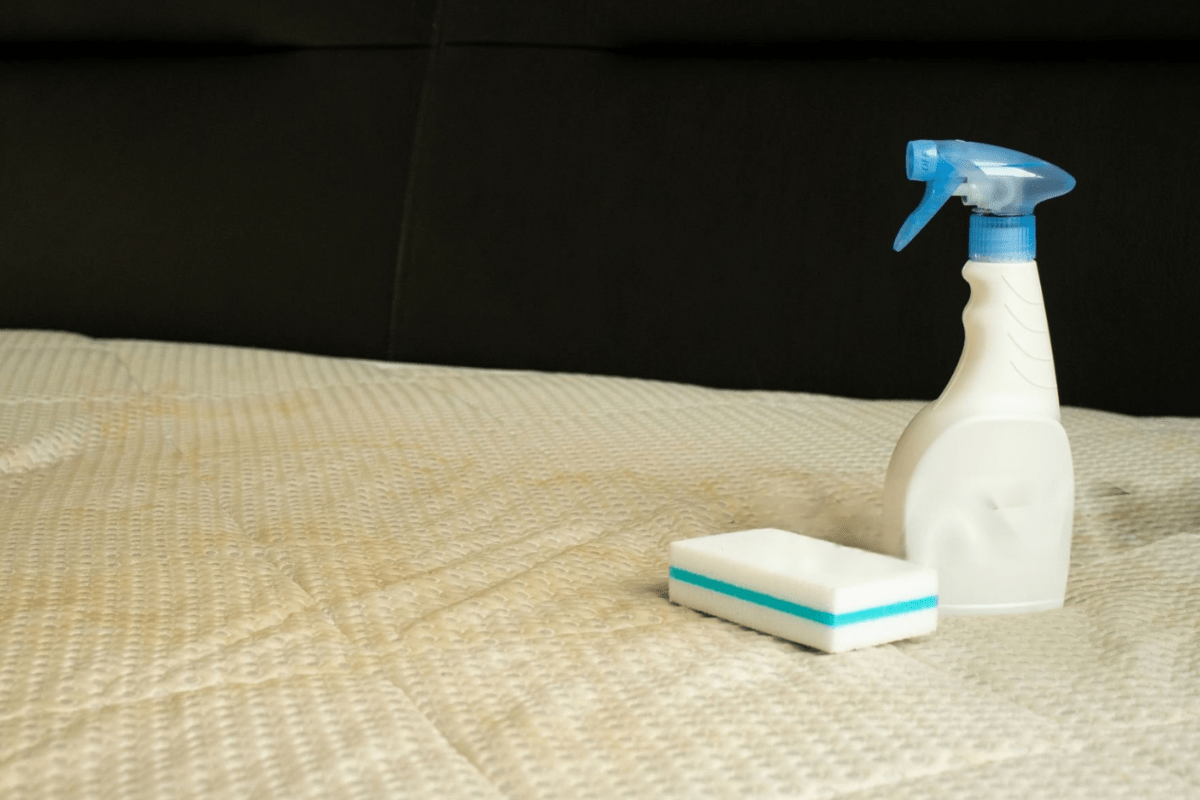
Air Dry Completely
Memory foam absorbs moisture easily, which is why letting it dry fully becomes essential after cleaning. Placing the mattress near a fan or keeping a window open speeds up the drying process without adding heat. Some prefer using a hair dryer on the cool setting, especially for targeted damp spots. Before storing or compressing your mattress for transport or long term use, it’s important to ensure it’s completely dry.
Covering a foam mattress before it’s completely dry traps moisture inside, which can create the right conditions for mold to grow. Even if it feels dry on the surface, there’s often lingering dampness deeper in the layers. Airing it out longer avoids this problem.
Sleeping on a damp foam mattress doesn’t just feel uncomfortable, it affects hygiene too. Moisture inside the foam can attract dust or odors that don’t go away easily. Patience goes a long way here since a properly dried mattress lasts longer and stays fresh.
Dealing With Dried Or Set-In Stains
Set-in stains can be tough to clean, but not impossible. Some people start with white vinegar and baking soda. If the stain has been there a while, it might take a few tries. For deeper stains, a mix of hydrogen peroxide, baking soda, and dish soap often works better. When the mix starts to fizz, it helps pull the stain out. It’s best to blot the area gently. Rubbing can damage the fabric.
Hydrogen peroxide doesn’t work well on all fabrics. It’s a good idea to test a small hidden area first. People who used this on light-colored sheets or cotton said the stains got lighter after one or two rounds. The trick is to be patient. Don’t soak the fabric too much each time. Just apply the mix, blot, and wait.
Protect Your Mattress In The Future
A freshly cleaned mattress doesn’t stay that way for long without protection. A waterproof mattress protector helps block spills, sweat, or pet messes from soaking through to the foam. It adds a simple layer that keeps the mattress dry and easier to maintain. Some people think a protector changes how a bed feels, but most are soft and breathable. They fit like a fitted sheet, so they don’t bunch or shift during sleep. It’s one of those things that’s barely noticeable until something spills, and then it’s essential.
Over time, even minor moisture can wear down foam or leave musty smells. A quality protector acts like a barrier against that damage. It also keeps dust mites and allergens from collecting, which helps extend the mattress’s comfort and lifespan. To further preserve your mattress’s condition, pay attention to how often you rotate a memory foam mattress and ways to make it firmer, as well as proper disposal methods when it reaches the end of its usable life.
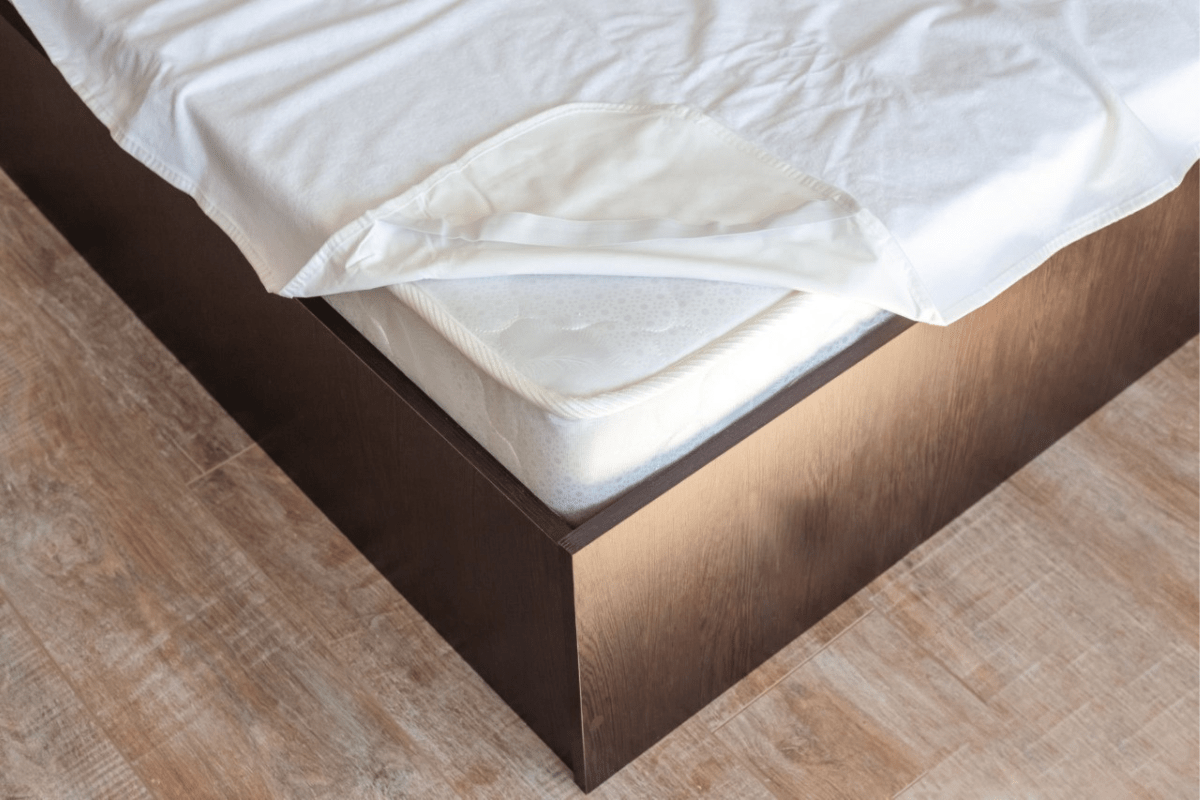
Urine Smell Still Lingering?
Some people swear by leaving a bowl of baking soda or activated charcoal near the mattress after cleaning. The smell doesn’t disappear right away, so letting these sit for a couple of days helps absorb whatever’s left in the air. It’s a low-effort fix that’s great for those who didn’t want to use more sprays or chemicals.
Opening the windows every day helps more than most expect. The breeze carries out trapped smells and keeps the room from getting stuffy again. Those who keep their rooms sealed up tend to notice the odor sticks around longer, no matter how hard they scrubbed.
Mattress smells tend to fade slower when the room is closed off or humid. It helps to keep fans running and curtains open during the day. Some also rotate their mattress to make sure every part airs out evenly, especially if the urine soaked in deeper than expected.
Final Thoughts
Dealing with urine on a memory foam mattress is overwhelming at first, especially since the material absorbs liquid quickly. However, using household items like distilled white vinegar and baking soda helps lift the smell and break down the stain. It just takes a bit of time, blotting, and the right method to see progress.
Acting fast usually prevents the urine from soaking deep into the foam. Letting it sit longer can cause the smell to linger and make cleanup harder. Blotting, not scrubbing, removes excess moisture better without damaging the surface.
After cleaning, airing the mattress out under a fan or near sunlight helps speed up the drying process. Some people place the mattress on its side to allow airflow to reach the deeper layers. A waterproof protector also helps for future accidents. It’s easier to wash a cover than deep-clean a mattress again. Knowing how to move a memory foam mattress along with how long it lasts and how often to replace it helps maintain its condition and ensures you get the most out of your cleaning efforts.

